2016 FIAT 500X maintenance
[x] Cancel search: maintenancePage 461 of 587
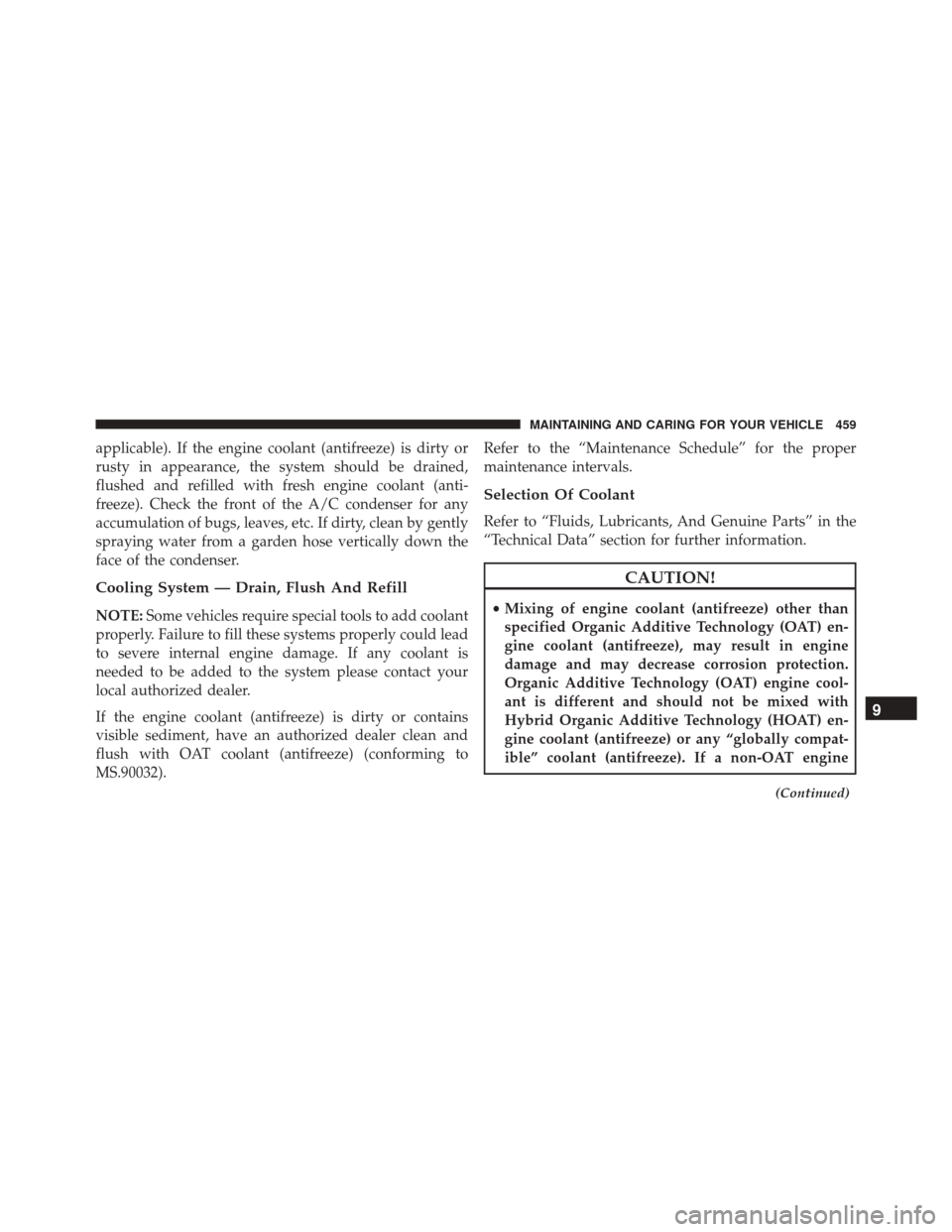
applicable). If the engine coolant (antifreeze) is dirty or
rusty in appearance, the system should be drained,
flushed and refilled with fresh engine coolant (anti-
freeze). Check the front of the A/C condenser for any
accumulation of bugs, leaves, etc. If dirty, clean by gently
spraying water from a garden hose vertically down the
face of the condenser.
Cooling System — Drain, Flush And Refill
NOTE:Some vehicles require special tools to add coolant
properly. Failure to fill these systems properly could lead
to severe internal engine damage. If any coolant is
needed to be added to the system please contact your
local authorized dealer.
If the engine coolant (antifreeze) is dirty or contains
visible sediment, have an authorized dealer clean and
flush with OAT coolant (antifreeze) (conforming to
MS.90032). Refer to the “Maintenance Schedule” for the proper
maintenance intervals.
Selection Of Coolant
Refer to “Fluids, Lubricants, And Genuine Parts” in the
“Technical Data” section for further information.
CAUTION!
•
Mixing of engine coolant (antifreeze) other than
specified Organic Additive Technology (OAT) en-
gine coolant (antifreeze), may result in engine
damage and may decrease corrosion protection.
Organic Additive Technology (OAT) engine cool-
ant is different and should not be mixed with
Hybrid Organic Additive Technology (HOAT) en-
gine coolant (antifreeze) or any “globally compat-
ible” coolant (antifreeze). If a non-OAT engine
(Continued)
9
MAINTAINING AND CARING FOR YOUR VEHICLE 459
Page 462 of 587
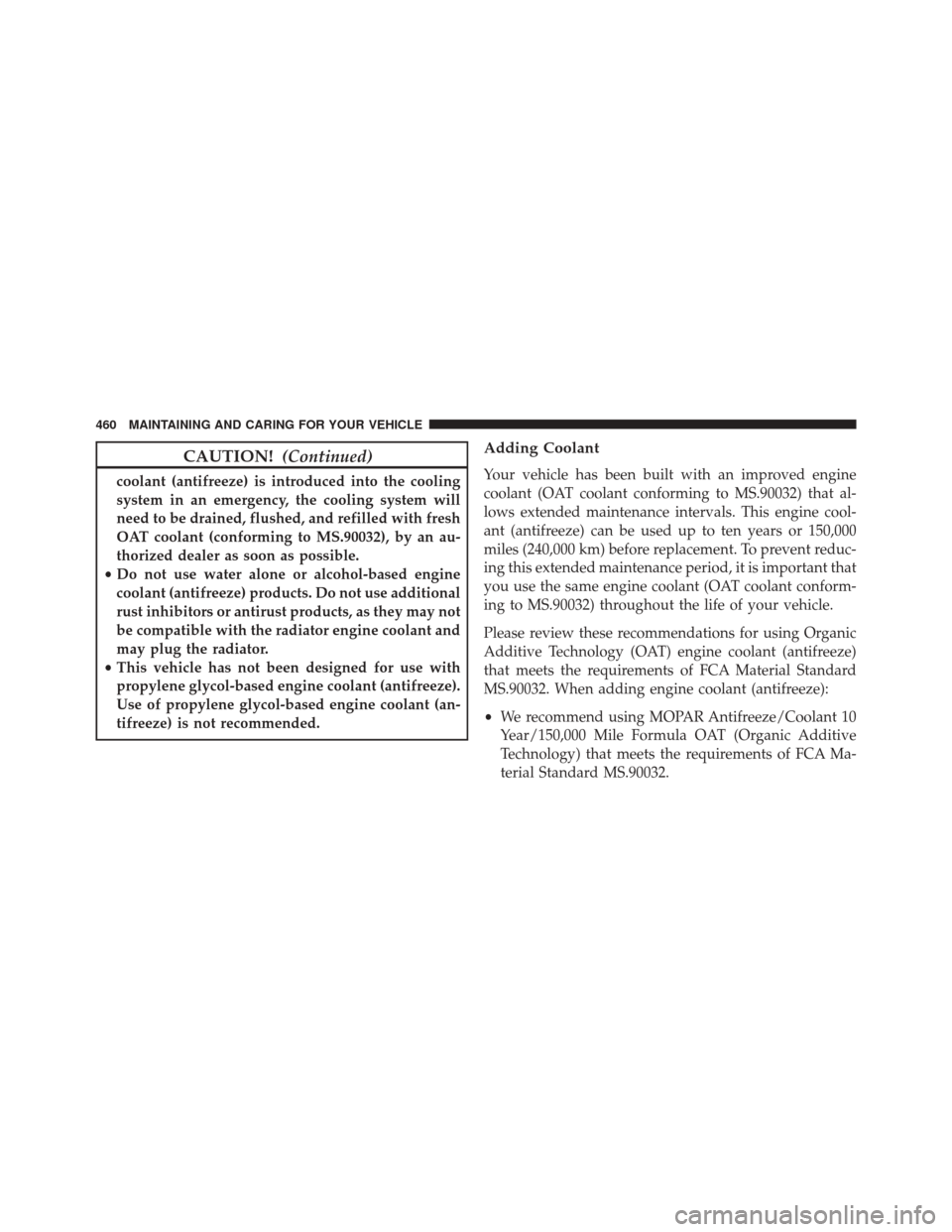
CAUTION!(Continued)
coolant (antifreeze) is introduced into the cooling
system in an emergency, the cooling system will
need to be drained, flushed, and refilled with fresh
OAT coolant (conforming to MS.90032), by an au-
thorized dealer as soon as possible.
• Do not use water alone or alcohol-based engine
coolant (antifreeze) products. Do not use additional
rust inhibitors or antirust products, as they may not
be compatible with the radiator engine coolant and
may plug the radiator.
• This vehicle has not been designed for use with
propylene glycol-based engine coolant (antifreeze).
Use of propylene glycol-based engine coolant (an-
tifreeze) is not recommended.
Adding Coolant
Your vehicle has been built with an improved engine
coolant (OAT coolant conforming to MS.90032) that al-
lows extended maintenance intervals. This engine cool-
ant (antifreeze) can be used up to ten years or 150,000
miles (240,000 km) before replacement. To prevent reduc-
ing this extended maintenance period, it is important that
you use the same engine coolant (OAT coolant conform-
ing to MS.90032) throughout the life of your vehicle.
Please review these recommendations for using Organic
Additive Technology (OAT) engine coolant (antifreeze)
that meets the requirements of FCA Material Standard
MS.90032. When adding engine coolant (antifreeze):
• We recommend using MOPAR Antifreeze/Coolant 10
Year/150,000 Mile Formula OAT (Organic Additive
Technology) that meets the requirements of FCA Ma-
terial Standard MS.90032.
460 MAINTAINING AND CARING FOR YOUR VEHICLE
Page 466 of 587
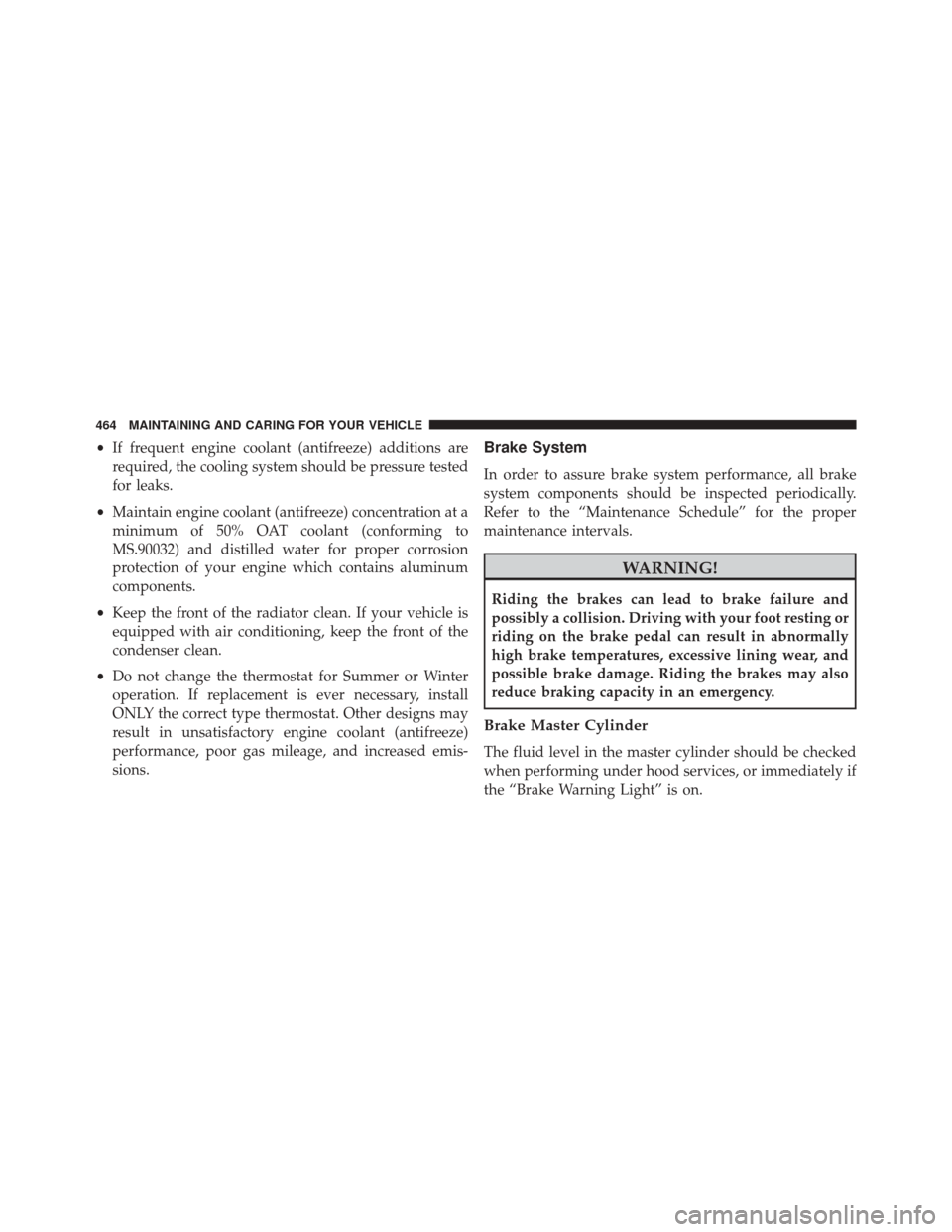
•If frequent engine coolant (antifreeze) additions are
required, the cooling system should be pressure tested
for leaks.
• Maintain engine coolant (antifreeze) concentration at a
minimum of 50% OAT coolant (conforming to
MS.90032) and distilled water for proper corrosion
protection of your engine which contains aluminum
components.
• Keep the front of the radiator clean. If your vehicle is
equipped with air conditioning, keep the front of the
condenser clean.
• Do not change the thermostat for Summer or Winter
operation. If replacement is ever necessary, install
ONLY the correct type thermostat. Other designs may
result in unsatisfactory engine coolant (antifreeze)
performance, poor gas mileage, and increased emis-
sions.Brake System
In order to assure brake system performance, all brake
system components should be inspected periodically.
Refer to the “Maintenance Schedule” for the proper
maintenance intervals.
WARNING!
Riding the brakes can lead to brake failure and
possibly a collision. Driving with your foot resting or
riding on the brake pedal can result in abnormally
high brake temperatures, excessive lining wear, and
possible brake damage. Riding the brakes may also
reduce braking capacity in an emergency.
Brake Master Cylinder
The fluid level in the master cylinder should be checked
when performing under hood services, or immediately if
the “Brake Warning Light” is on.
464 MAINTAINING AND CARING FOR YOUR VEHICLE
Page 471 of 587
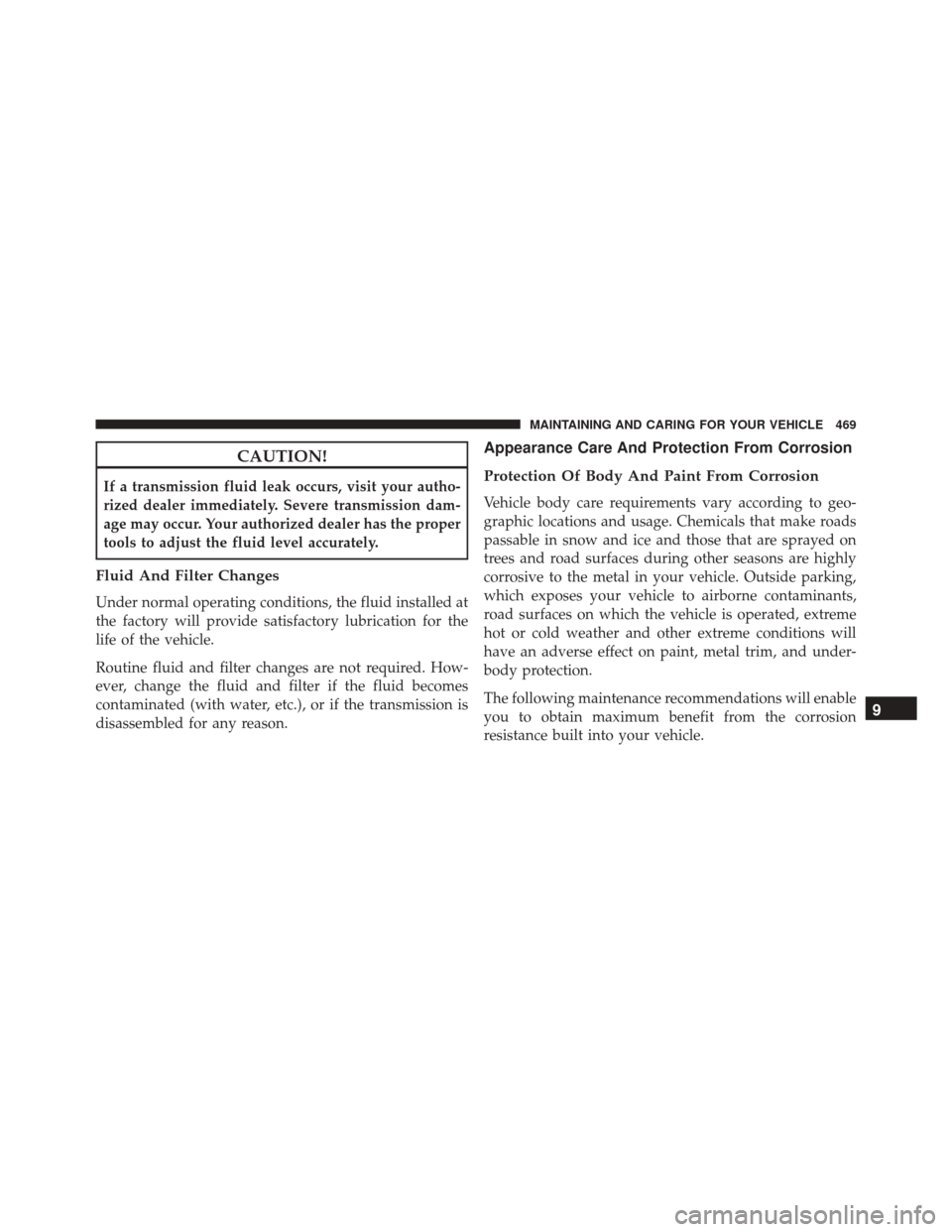
CAUTION!
If a transmission fluid leak occurs, visit your autho-
rized dealer immediately. Severe transmission dam-
age may occur. Your authorized dealer has the proper
tools to adjust the fluid level accurately.
Fluid And Filter Changes
Under normal operating conditions, the fluid installed at
the factory will provide satisfactory lubrication for the
life of the vehicle.
Routine fluid and filter changes are not required. How-
ever, change the fluid and filter if the fluid becomes
contaminated (with water, etc.), or if the transmission is
disassembled for any reason.
Appearance Care And Protection From Corrosion
Protection Of Body And Paint From Corrosion
Vehicle body care requirements vary according to geo-
graphic locations and usage. Chemicals that make roads
passable in snow and ice and those that are sprayed on
trees and road surfaces during other seasons are highly
corrosive to the metal in your vehicle. Outside parking,
which exposes your vehicle to airborne contaminants,
road surfaces on which the vehicle is operated, extreme
hot or cold weather and other extreme conditions will
have an adverse effect on paint, metal trim, and under-
body protection.
The following maintenance recommendations will enable
you to obtain maximum benefit from the corrosion
resistance built into your vehicle.
9
MAINTAINING AND CARING FOR YOUR VEHICLE 469
Page 477 of 587

Instrument Panel Bezels
CAUTION!
When installing hanging air fresheners in your ve-
hicle, read the installation instructions carefully.
Some air fresheners will damage the finish of
painted or decorated parts if allowed to directly
contact any surface.
Cleaning Plastic Instrument Cluster Lenses
The lenses in front of the instruments in this vehicle are
molded in clear plastic. When cleaning the lenses, care
must be taken to avoid scratching the plastic.
1. Clean with a wet soft cloth. A mild soap solution maybe used, but do not use high alcohol content or
abrasive cleaners. If soap is used, wipe clean with a
clean damp cloth. 2. Dry with a soft cloth.
Seat Belt Maintenance
Do not bleach, dye or clean the belts with chemical
solvents or abrasive cleaners. This will weaken the fabric.
Sun damage can also weaken the fabric.
If the belts need cleaning, use a mild soap solution or
lukewarm water. Do not remove the belts from the
vehicle to wash them. Dry with a soft cloth.
Replace the belts if they appear frayed or worn or if the
buckles do not work properly.
9
MAINTAINING AND CARING FOR YOUR VEHICLE 475
Page 503 of 587
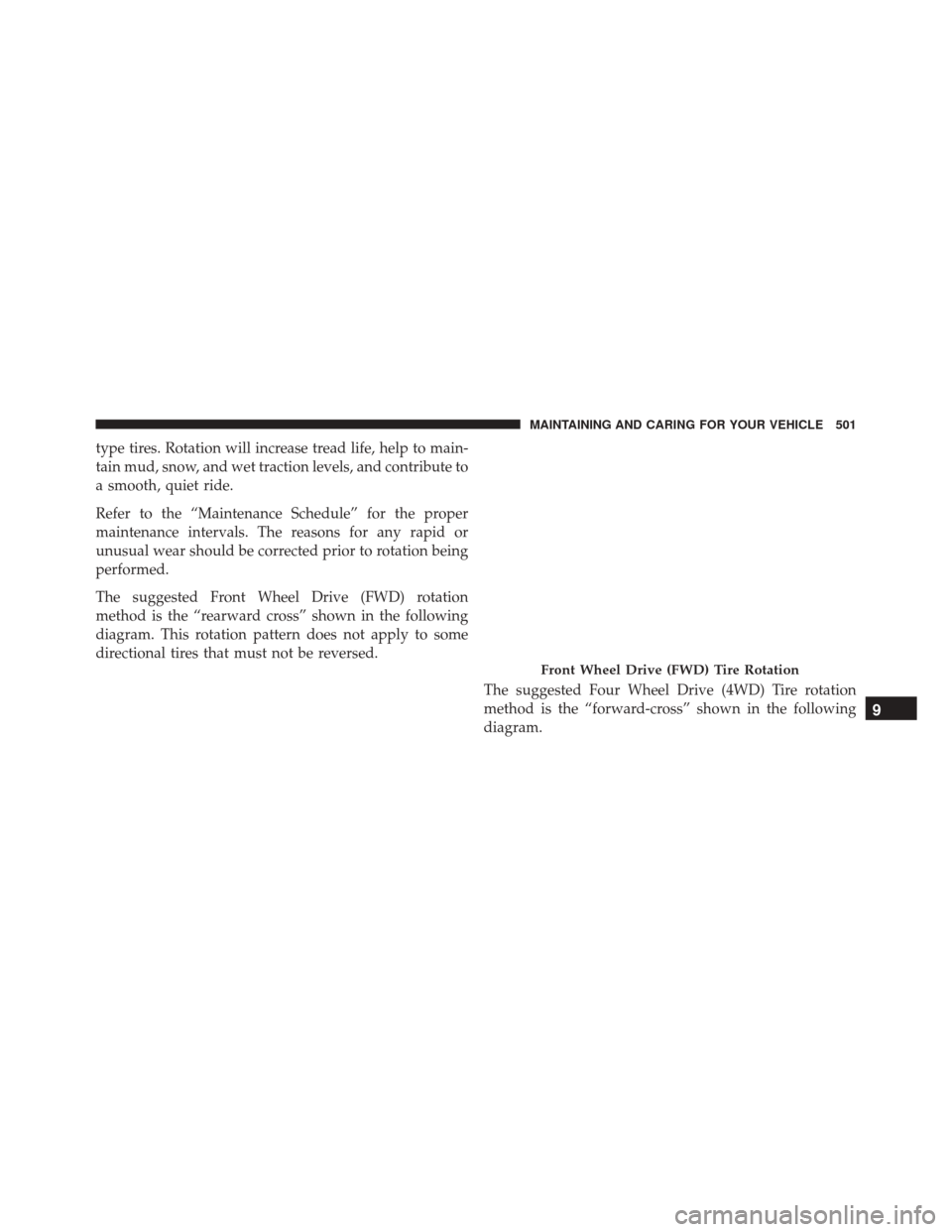
type tires. Rotation will increase tread life, help to main-
tain mud, snow, and wet traction levels, and contribute to
a smooth, quiet ride.
Refer to the “Maintenance Schedule” for the proper
maintenance intervals. The reasons for any rapid or
unusual wear should be corrected prior to rotation being
performed.
The suggested Front Wheel Drive (FWD) rotation
method is the “rearward cross” shown in the following
diagram. This rotation pattern does not apply to some
directional tires that must not be reversed.The suggested Four Wheel Drive (4WD) Tire rotation
method is the “forward-cross” shown in the following
diagram.
Front Wheel Drive (FWD) Tire Rotation
9
MAINTAINING AND CARING FOR YOUR VEHICLE 501
Page 570 of 587

About Your Brakes....................... .197
Adding Engine Coolant (Antifreeze) ............460
Adding Fuel ............................ .340
Adding Washer Fluid ..................... .455
Additives, Fuel .......................... .338
AirBag ............................... .224
Advance Front Air Bag ................224, 225
Air Bag Operation ...................... .227
Air Bag Warning Light ...................237
Driver Knee Air Bag .....................228
Event Data Recorder (EDR) ................240
FrontAirBag ......................... .224
If A Deployment Occurs ..................234
Knee Impact Bolsters .....................228
Maintaining Your Air Bag System ............239
Redundant Air Bag Warning Light ...........239
Side Air Bags ......................... .228
Transporting Pets ...................... .262
Air Bag Deployment ...................... .224Air Bag Light
........................ .237, 264
Air Bag Maintenance ...................... .239
Air Cleaner, Engine (Engine Air Cleaner Filter) . . . .449
Air Conditioner Maintenance ..........113,126, 451
Air Conditioning ..................... .109, 124
Air Conditioning Controls ...................109
Air Conditioning Filter .....................452
Air Conditioning Refrigerant ..............451, 452
Air Conditioning System .................109, 451
Air Pressure, Tires ........................ .490
Air Recirculation ......................113,123
Alarm Arm The System ........................50
All Wheel Drive (AWD) .....................305
Alterations/Modifications, Vehicle ...............7
Antifreeze (Engine Coolant) ...............459, 509
Disposal ............................. .462
Anti-Lock Brake System (ABS) ................198
Appearance
Care ........................ .469
568 INDEX
Page 574 of 587
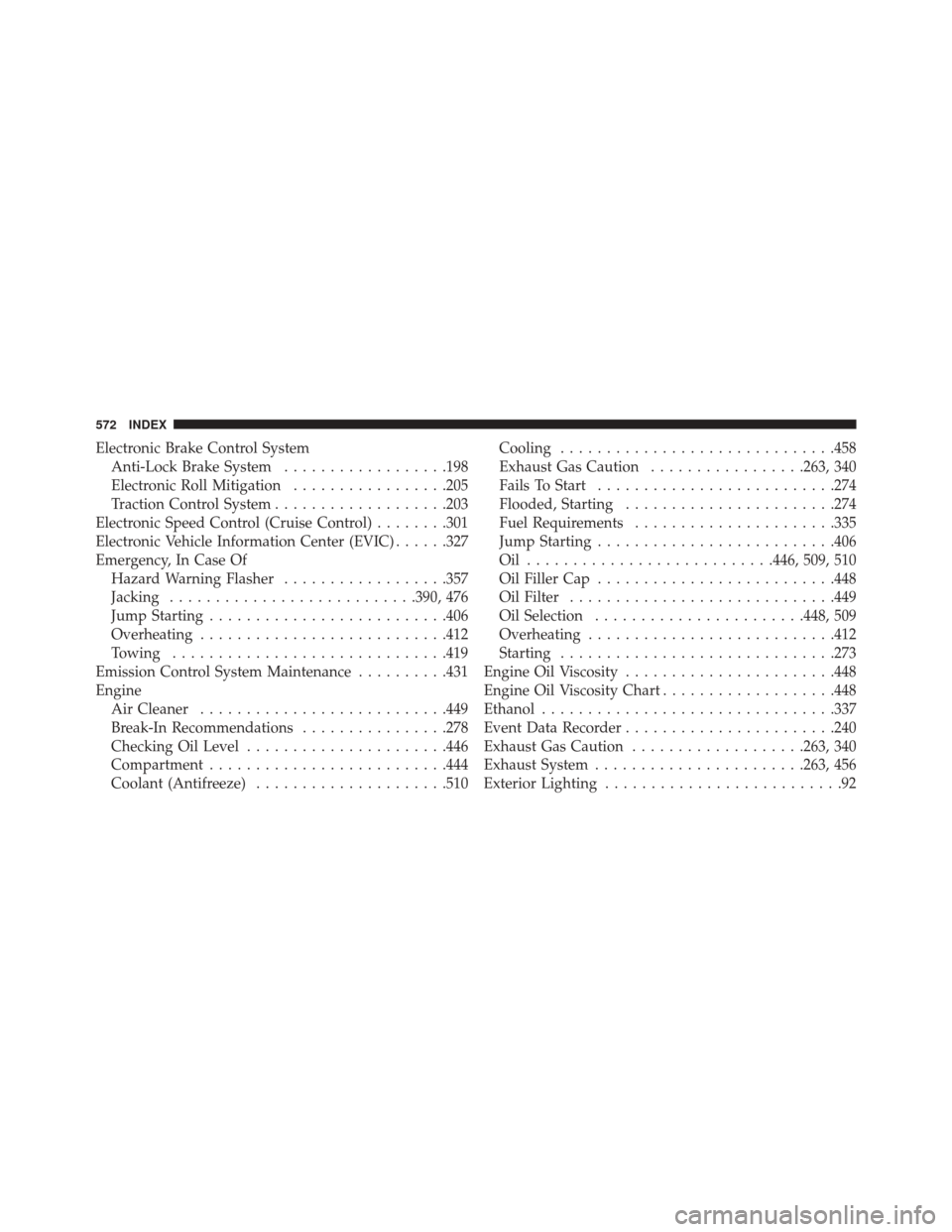
Electronic Brake Control SystemAnti-Lock Brake System ..................198
Electronic Roll Mitigation .................205
Traction Control System ...................203
Electronic Speed Control (Cruise Control) ........301
Electronic Vehicle Information Center (EVIC) ......327
Emergency, In Case Of Hazard Warning Flasher ..................357
Jacking .......................... .390, 476
Jump Starting ......................... .406
Overheating .......................... .412
Towing ............................. .419
Emission Control System Maintenance ..........431
Engine Air Cleaner .......................... .449
Break-In Recommendations ................278
Checking Oil Level ..................... .446
Compartment ......................... .444
Coolant (Antifreeze) .....................510 Cooling
............................. .458
Exhaust Gas Caution .................263, 340
Fails To Start ......................... .274
Flooded, Starting ...................... .274
Fuel Requirements ..................... .335
Jump Starting ......................... .406
Oil .......................... .446, 509, 510
Oil Filler Cap ......................... .448
Oil Filter ............................ .449
Oil Selection ...................... .448, 509
Overheating .......................... .412
Starting ............................. .273
Engine Oil Viscosity ...................... .448
Engine Oil Viscosity Chart ...................448
Ethanol ............................... .337
Event Data Recorder ...................... .240
Exhaust Gas Caution ...................263, 340
Exhaust System ...................... .263,
456
Exterior Lighting ..........................92
572 INDEX